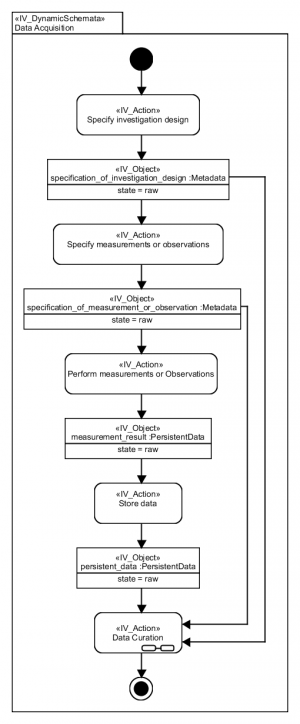Revision as of 15:15, 27 March 2020
This section expands the IV Lifecycle Overview of the alignment between the information viewpoint and the data lifecycle. The descriptions uses the IV Information Objects and IV Information Action Types to a greater extent providing a deeper insight into the processing of information objects by the RI.
The notation for the diagrams in this section is as follows. The rounded rectangles represent IV actions on data and the straight rectangles represent instances of information objects at different stages. The arrow lines link actions and objects as follows: arrows leaving an action connect to IV objects created by the action while arrows entering an action connect IV objects to actions using them.
Data Acquisition
Data Curation
Data Publishing
Data Processing
Data Use
Data Acquisition
The data acquisition phase encompasses the actions defined for the observation/experimentation, storage, identification and backup of measurements/observations (raw data).
The following paragraphs explain the detailed diagram of how the IV actions can be combined to support data acquisition.
Note
This example is provided for illustrative purposes. The example shows one of many alternatives for performing data acquisition. Other IV actions and IV objects can be introduced at this stage. Additional actions and objects not described in the IV of the ENVRI RM can also be incorporated.
Specify investigation design: Before a measurement or observation can be started the design (or setup) must be defined, including the working hypothesis and scientific question, method of the selection of sites (stratified / random), necessary precision of the observation or measurement, boundary conditions, etc. For correctly using the resulting data, details about their processing, and the parameters defined have to be available (e.g. if a stratified selection of sites according to parameter A is done, the resulting value of parameter A can not be evaluated in the same way as other results).
Specify measurement or observation: After defining the overall design of measurements or observations, the measurement method, complying with the design, including devices which should be used, standards / protocols which should be followed, and other details have to be specified. The details of the process and the parameters used have to preserved to guarantee correct interpretation of the resulting data (e.g. when modelling a dependency of parameter B of a parallel measured wind velocity, the limit of detection of the used anemometer influences the range of values of possible assertions).
Perform measurement or observation: After the measurement or observation method is defined, the experiment can be performed, producing measurement result(s) which is a form of persistent data in a raw state.
Store data: The measurement result data is stored.This action can be very simple when using a measurement device, which periodically sends the data to the data management system, but this can also be a sophisticated harvesting process or e.g. in case of biodiversity observations a process done by humans. The storage process is the first step in the lifecycle of data that makes data accessible in digital form.
Data curation: Once data is stored, the next phase of the data lifecycle is data curation.
|
Data Acquisition
|

Notation
|
|
